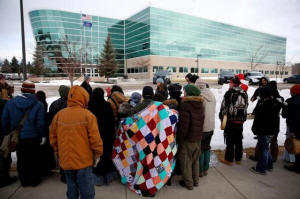|
Activist ire rises as Dakota pipeline
review begins
 Send a link to a friend
Send a link to a friend
 [February 02, 2017]
By Valerie Volcovici and Terray Sylvester [February 02, 2017]
By Valerie Volcovici and Terray Sylvester
WASHINGTON/CANNON BALL, N.D. (Reuters) -
Native Americans and activists protesting the Dakota Access Pipeline
project expressed alarm on Wednesday after federal lawmakers from North
Dakota said the final permit had been granted for the project, a
statement later contradicted by the Army, which issues such permits.
The U.S. Army Corps of Engineers said on Wednesday it has started a
review for the permit but that the easement had not been granted. "The
Assistant Secretary for the Army Civil Works will make a decision on the
pipeline once a full review and analysis is completed in accordance with
the directive," it said in a statement.
(Graphic:
http://fingfx.thomsonreuters.com/gfx/rngs/USA-PIPELINE-NATIVEAMERICANS/010021PV463/index.html)
Activists in North Dakota expressed anger after two lawmakers said late
on Tuesday that final right-of-way for the pipeline had already been
approved.
In a statement late on Tuesday, activists at the Sacred Stone camp, the
original protest camp on Standing Rock Sioux land, called on other
activists to return for prayer and "direct action."
The Standing Rock Sioux tribe, along with other Native American groups,
environmentalists and other activists have argued that the $3.8 billion
Dakota Access Pipeline led by Energy Transfer Partners LP would damage
sacred lands and could leak oil into the tribe's water supply.
Proponents believe the pipeline is necessary to transport U.S. oil
safely and that it would create jobs.

The pipeline would stretch for 1,170 miles (1,885 km) from North
Dakota's oil-producing Bakken region to Patoka, Illinois.
The Standing Rock Sioux tribe had successfully won delays from the Obama
administration for further environmental review, but last week President
Donald Trump signed an executive order telling the Corps of Engineers to
expedite review of the project. It is unclear how long that review will
take.
It still needs a required permit to tunnel under Lake Oahe, a reservoir
that is part of the Missouri River. The reservoir is the water source
for the Standing Rock Sioux Reservation, whose land in Cannon Ball is
adjacent to the line's route.
Jade Begay, spokeswoman for the Indigenous Environmental Network, a
nonprofit group and one of the primary groups protesting the line, said:
“People (in protest camps) are watching pretty closely. People are in a
reactionary place and it is dangerous for politicians to put out these
unfounded statements."
In a statement posted on their website, the Sacred Stone camp - the
original camp, established last April - asked protesters to return to
their encampment so that they could stage another demonstration. That
camp is located on Sioux land in Sioux County; it is not the site of the
bulk of protests, which are in Morton County on federal land.
FEAR AND ANGER
The main protest camp, known as Oceti Sakowin, had been the staging
ground for ongoing protests, some of which led to violent clashes
between law enforcement and activists.
That camp is in the process of being broken down, because it is located
on a flood plain, and when it floods, any remaining structures could
foul the river.
[to top of second column] |

Opponents of the Dakota Access oil pipeline rally outside the Bank
of North Dakota in Bismarck, North Dakota, U.S., January 31, 2017.
REUTERS/Terray Sylvester

Protesters on Wednesday attempted to set up another camp across from
Oceti Sakowin, on the other side of Highway 1806, on private
property. In a press release, North Dakota law enforcement said they
asked protesters to leave the camp, and after refusals, evicted
about 40 people from that land, which is owned by Dakota Access.
On Tuesday, U.S. Senator John Hoeven of North Dakota said in a
statement that Acting Secretary of the Army Robert Speer had told
him and Vice President Mike Pence that Speer directed the Corps to
proceed with the easement. U.S. Representative Kevin Cramer also
said he had been informed of the directive.
A spokesman for Hoeven, Don Canton, said on Wednesday that Speer
told the senator that the Army Corps was doing its due diligence in
acting on Trump's memo from last week, and that Hoeven had not
discussed the environmental study with the Corps.
Lewis Grassrope, a member of the Lower Brule Sioux Tribe in South
Dakota, said the Trump administration and North Dakota lawmakers
were trying to inspire fear and anger through premature statements.
"They want us to react and go do actions, which will give them the
right to say, 'OK, they're not peaceful. So let's put in this
pipeline,'" he said.
Several groups opposing the project, including the Standing Rock
Sioux, said they would fight the granting of an easement in court,
as an environmental study still needs to be completed.
Standing Rock Sioux Chairman Dave Archambault II last week said he
requested a meeting with Trump, but has not received a response.
Standing Rock representatives were not available for comment on
Wednesday, but Begay said that "Trump, when he made these executive
orders, did not have any consultation with tribal leaders."

(Additional reporting by Susan Heavey in Washington and Ernest
Scheyder in Houston; Writing by David Gaffen; Editing by Dan Grebler
and Matthew Lewis)
[© 2017 Thomson Reuters. All rights
reserved.]
Copyright 2017 Reuters. All rights reserved. This material may not be published,
broadcast, rewritten or redistributed. |